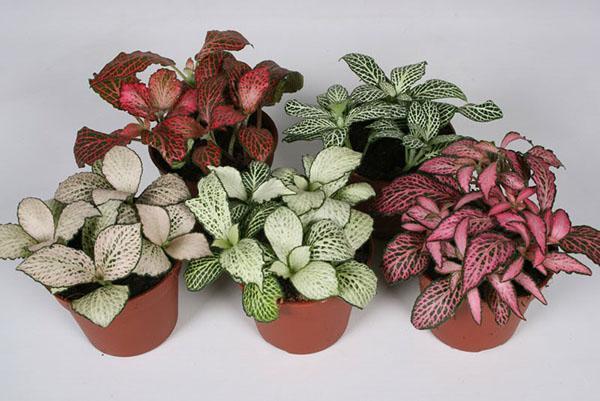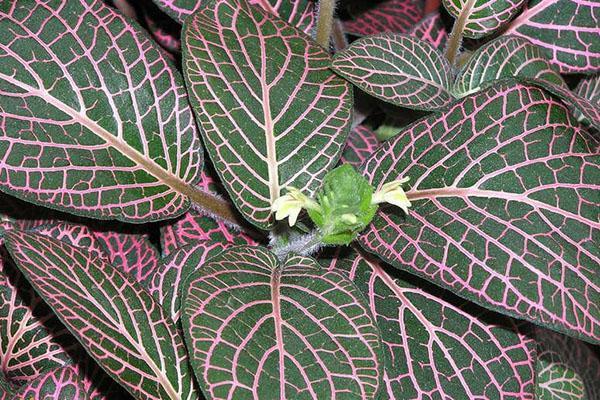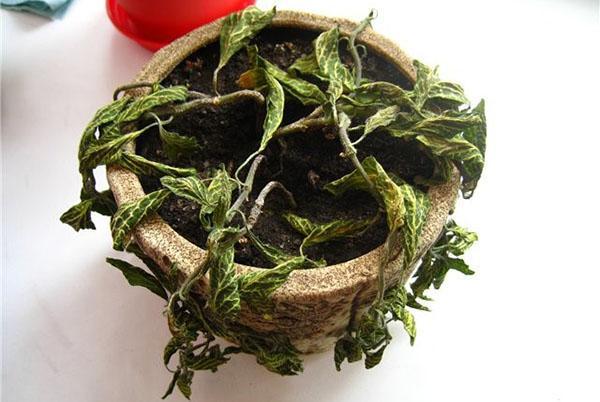Features of growing fittonia at home
 Fittonia is a popular decorative deciduous plant native to South America. It is appreciated by flower growers for its unusual and bright color of leaves. Two types are used as a room culture: Vershafelt fittonia and Silver-veined. Their main difference is the color of the leaves and the demand for care.
Fittonia is a popular decorative deciduous plant native to South America. It is appreciated by flower growers for its unusual and bright color of leaves. Two types are used as a room culture: Vershafelt fittonia and Silver-veined. Their main difference is the color of the leaves and the demand for care.
Botanical description

Fittonia shoots have dense pubescence, silvery at a young age, greenish at an older age, and elliptical leaves, about 6-8 cm in size. Their characteristic distinguishing feature is the presence of a mesh of veins on the surface, which, depending on the species, is deep pink or white.
Fittonia flowers are not very decorative, small, inconspicuous, collected in small spike-shaped inflorescences. Each in the lower part is closed by a rather large bracts.
Growing conditions
 When choosing a location and lighting for fittonia, it is taken into account that the plant needs bright diffused light. South and southeast windows are best suited for it. In the summer, the flower pot is placed at some distance from the window or slightly shaded, and in the winter it is placed directly on the windowsill.
When choosing a location and lighting for fittonia, it is taken into account that the plant needs bright diffused light. South and southeast windows are best suited for it. In the summer, the flower pot is placed at some distance from the window or slightly shaded, and in the winter it is placed directly on the windowsill.
Placing Fittonia in direct sunlight will cause severe leaf burns.
The temperature and humidity for Fittonia should correspond to the conditions of warm and humid tropics. And an earthen lump in a flowerpot with a plant should always be in a slightly damp state. In winter, especially with a cool content, the intensity of watering is reduced. Stagnant moisture, combined with low temperatures, will lead to the death of the plant.
For fittonias periodic spraying with warm, settled water is very useful. Especially when growing a plant in a city apartment with dry air. It is also useful to place small containers of water next to the flowerpot to increase the level of humidity. In winter, they try to place Fittonia as far as possible from the batteries. Their withering action is detrimental to its delicate leaves. Fittonia is a thermophilic crop. The optimum temperature for her in winter is 20-25 °.
With a prolonged temperature drop below + 18 °, the plant may die.
The ideal conditions for growing Fittonia are a stable 22-24 ° C heat regardless of the season and a complete absence of drafts and sudden temperature changes.
Care
Caring for Fittonia at home is not particularly difficult. She has the ability to perfectly adapt to a wide variety of conditions. You can grow a plant both in an ordinary apartment with centralized heating, and in a private house. The main thing is to provide him with appropriate care.
Transfer
 The choice of soil and the transplantation of fittonia must be carried out taking into account its biological requirements. The best time for replanting is spring. The soil is made up of two parts of sod land, 1 part of clean river sand and two parts of peat.
The choice of soil and the transplantation of fittonia must be carried out taking into account its biological requirements. The best time for replanting is spring. The soil is made up of two parts of sod land, 1 part of clean river sand and two parts of peat.
If there is no opportunity for self-compilation of an earthen mixture, use a universal substrate for growing indoor plants.
It is best to choose a transplant pot wide and flat. In it, the plant feels as comfortable as possible. Also, in flowerpots, a layer of expanded clay drainage is necessarily equipped.
Pruning
 Pruning Fittonia is one of the most essential maintenance activities. Growing a lush and beautiful plant without it will not work. Young, fast-growing specimens especially need pruning. On them, it is carried out by plucking the tops of the shoots.
Pruning Fittonia is one of the most essential maintenance activities. Growing a lush and beautiful plant without it will not work. Young, fast-growing specimens especially need pruning. On them, it is carried out by plucking the tops of the shoots.
In cases where the plant is already overgrown and its shoots have become too long and ugly, a more radical reconstruction of the bush is required. During her, the stems of the plant are cut almost to the very base.
Top dressing
Fertilization for Fittonia is carried out during the period of active growth with an interval of 2-3 weeks. To feed the plant, any complex mineral fertilizer is used for decorative leafy crops. It should be diluted according to the attached instructions.
Pest control
Like any other plant, Fittonia is attacked by pests. The following types are most often found on it:
- Aphid.
- Thrips.
- Shield.
- Whitefly.
Fight them with insecticidal preparations. For example, you can use "Aktara", "Commander", "Tanrek". They should be diluted and used in strict accordance with the attached annotation.
The most common growing problems
 Fittonia is a rather delicate plant that requires strict adherence to agricultural technology. The most common problems when growing it are the following:
Fittonia is a rather delicate plant that requires strict adherence to agricultural technology. The most common problems when growing it are the following:
- Drying of the tips of the leaves. Most often, the main reason lies in too dry air. The affected leaves are removed, and the plant itself is regularly sprayed with warm, settled water.
- The stems and leaves of the plant lose their turgor and look wilted. This condition is the result of insufficient moisture. It should be watered regularly and in a timely manner, the earthen lump in the plant pot should always be slightly damp.
- Too long internodes and small leaves - the plant lacks lighting. The pot should be moved to a brighter place.
- Sluggish stems rotting near the base. Most often, this condition is a consequence of the bay. Watering should be stopped, and the earthen lump should be dried.
All the efforts spent on growing demanding Fittonia will more than pay off with its spectacular appearance. In addition, this charming ornamental leafy plant can become a real decoration of a miniature bottle garden or terrarium.